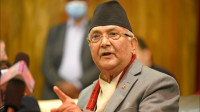The government has decided to close down its borders with both India and China for a week, effective from 10am Monday, to deal with the ongoing Covid-19 outbreak.
A Cabinet meeting on Sunday took a decision to this effect.
“Today’s Cabinet meeting decided to close all borders starting 10am Monday,” said Foreign Minister Pradeep Gyawali. “We have also decided to develop a fund of Rs500 million, for which all ministers will donate a month’s salary.”
The fund will be utilised to purchase personal protective gear, masks, thermometers, ventilators and monitors, among other equipment required in the fight against the coronavirus pandemic.
The government has also decided to develop the Armed Police Force Hospital in Balambu as the primary hospital for the treatment of Covid-19.
Earlier, the governments of Nepal and India had decided to operate just four border points in the wake of the global Covid-19 pandemic. However, the movements of Nepalis and Indians were largely unrestricted, not only through the designated border points but also through other land crossings along the 1,800-km Nepal-India border which is largely unmanned.
As India continues to report a steady rise in the number of Covid-19 cases, Nepalis living and working in various Indian cities have started to return home, stoking concerns if they were properly screened before entering Nepal.
Calls had been growing to seal the border with India, but given the unique Nepal-India relations, cross-border movement had not been restricted.
With all flights to Nepal suspended, health experts had said that the only way the coronavirus could now enter Nepal, if it has not already, was via the open border with India.
Border points with China, however, had remained closed since the outbreak in China.
The Nepal government’s decision to shut the border with India comes hours after New Delhi decided to suspend all passenger trains, bus services, metro and inter-state bus services until March 31, putting all 75 districts where coronavirus cases have been reported under lockdown.
According to the Economic Times, the districts where the lockdown was announced are from states that include Uttar Pradesh, Maharashtra, Punjab, Karnataka, Tamil Nadu and Kerala.
“State governments will issue orders allowing only essential services to operate in these 75 districts with confirmed Covid-19 cases or casualties,” the Economic Times quoted a Union Home Ministry official as saying.
Nepal shares its border with two Indian states—Uttar Pradesh and Bihar. No travel restrictions have been imposed in Bihar as of yet.
According to the Indian Health Ministry, there have been 360 infections, including both foreigners and Indians, in the country. Uttar Pradesh has reported 27 cases while Bihar has had two cases. Seven people have died.
Frequently asked questions about the coronavirus outbreak
UPDATED as of September 22, 2020
What is Covid-19?
Covid-19, short for coronavirus disease, is an illness caused by the coronavirus SARS-CoV-2, short for severe acute respiratory syndrome coronavirus 2. Common symptoms of the disease include fever, dry cough, fatigue, shortness of breath and breathing difficulties. In severe cases, the infection can cause pneumonia, severe acute respiratory syndrome, kidney failure and even death.
How contagious is Covid-19?
Covid-19 can spread easily from person to person, especially in enclosed spaces. The virus can travel through the air in respiratory droplets produced when a sick person breathes, talks, coughs or sneezes. As the virus can also survive on plastic and steel surfaces for up to 72 hours and on cardboard for up to 24 hours, any contact with such surfaces can also spread the virus. Symptoms take between two to 14 days to appear, during which time the carrier is believed to be contagious.
Where did the virus come from?
The virus was first identified in Wuhan, China in late December. The coronavirus is a large family of viruses that is responsible for everything from the common cold to Middle East Respiratory Syndrome (MERS) and Severe Acute Respiratory Syndrome (SARS). After an initial outbreak in Wuhan that spread across Hubei province, eventually infecting over 80,000 and killing more than 3,000, new infection rates in mainland China have dropped. However, the disease has since spread across the world at an alarming rate.
What is the current status of Covid-19?
The World Health Organisation has called the ongoing outbreak a “pandemic” and urged countries across the world to take precautionary measures. Covid-19 has spread to 213 countries and territories around the world and infected more than 31,405,983 people with 967,505 deaths and 22,990,260 recoveries. In South Asia, India has reported the highest number of infections at 5,557,573 with 88,943 deaths. While Pakistan has reported 306,304 confirmed cases with 6,420 deaths. Nepal has so far reported 65,276 cases with 427 deaths.
How dangerous is the disease?
The mortality rate for Covid-19 is estimated to be 3.6 percent, but new studies have put the rate slightly higher at 5.7 percent. Although Covid-19 is not too dangerous to young healthy people, older individuals and those with immune-compromised systems are at greater risk of death. People with chronic medical conditions like heart disease, diabetes and lung disease, or those who’ve recently undergone serious medical procedures, are also at risk.
How do I keep myself safe?
The WHO advises that the most important thing you can do is wash your hands frequently with soap and water for at least 20 seconds or use hand sanitizers with at least 60 percent alcohol content. Avoid touching your eyes, nose and mouth with unclean hands. Clean and disinfect frequently used surfaces like your computers and phones. Avoid large crowds of people. Seek medical attention if symptoms persist for longer than a few days.
Is it time to panic?
No. The government has imposed a lockdown to limit the spread of the virus. There is no need to begin stockpiling food, cooking gas or hand sanitizers. However, it is always prudent to take sensible precautions like the ones identified above.





 7.15°C Kathmandu
7.15°C Kathmandu










%20(1).jpg&w=300&height=200)



